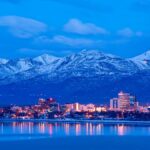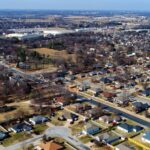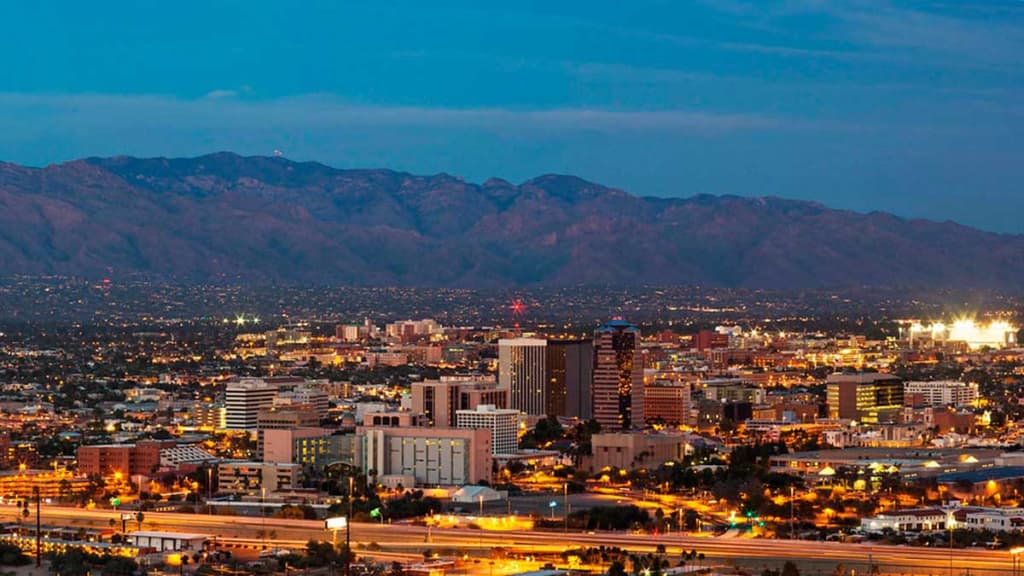
Arizona, known for its stunning landscapes ranging from the vast deserts of the Sonoran to the towering peaks of the Rockies, is also home to dynamic urban centers that contribute significantly to the state’s culture, economy, and social fabric. The state’s cities, each with its distinct personality and offerings, provide a glimpse into the diverse way of life that Arizona residents enjoy. This article delves into the most populous cities in Arizona, shedding light on their growth, attractions, and the challenges they face in an ever-evolving landscape.
The Top 10 Most Populous Cities in Arizona
Starting with Phoenix, the state capital and America’s fifth-largest city, the list includes other significant urban centers like Tucson, Mesa, Chandler, and Scottsdale, among others. This section will provide an overview of each city, including population figures and key facts that contribute to their ranking.
Phoenix
- Population: Over 1.7 million residents;
- Economic Sectors: Healthcare, finance, technology, and manufacturing;
- Notable Attractions: Desert Botanical Garden, Phoenix Art Museum, and South Mountain Park;
- Cultural Significance: The capital of Arizona, Phoenix serves as the state’s political, economic, and cultural hub. It hosts numerous cultural festivals, sports events, and is known for its vibrant arts scene.
Tucson
- Population: Over 550,000 residents;
- Economic Sectors: Education, aerospace, and defense, healthcare;
- Notable Attractions: Saguaro National Park, Tucson Museum of Art, and the historic El Presidio District;
- Cultural Significance: Tucson is renowned for its rich Native American, Spanish, and Mexican heritage, evident in its architecture, food, and annual cultural events like the Tucson Gem and Mineral Show.
Mesa
- Population: Nearly 500,000 residents;
- Economic Sectors: Aerospace, healthcare, education, and tourism;
- Notable Attractions: Mesa Arts Center, Usery Mountain Regional Park, and the Arizona Museum of Natural History;
- Cultural Significance: Mesa offers a blend of urban and natural attractions, with a strong emphasis on family-friendly activities and outdoor recreation.
Chandler
- Population: Over 260,000 residents;
- Economic Sectors: Technology, manufacturing, and retail;
- Notable Attractions: Chandler Fashion Center, Veterans Oasis Park, and the Chandler Center for the Arts;
- Cultural Significance: Chandler is known for its vibrant tech scene and annual events like the Ostrich Festival, celebrating its unique history and community spirit.
Scottsdale
- Population: Over 250,000 residents;
- Economic Sectors: Tourism, healthcare, and finance;
- Notable Attractions: Old Town Scottsdale, Scottsdale Museum of Contemporary Art, and Taliesin West;
- Cultural Significance: Scottsdale is famous for its luxury lifestyle, golf courses, and as a premier destination for art and nature lovers.
Glendale
- Population: Over 250,000 residents;
- Economic Sectors: Entertainment, education, and healthcare;
- Notable Attractions: State Farm Stadium, Glendale Historic District, and Westgate Entertainment District;
- Cultural Significance: Glendale is a sports and entertainment hub, hosting major events and offering a rich blend of cultural and outdoor activities.
Gilbert
- Population: Over 240,000 residents;
- Economic Sectors: Healthcare, technology, and retail;
- Notable Attractions: Riparian Preserve at Water Ranch, Gilbert Historical Museum, and Hale Centre Theatre;
- Cultural Significance: Gilbert is celebrated for its high quality of life, community-oriented lifestyle, and commitment to preserving natural spaces.
Tempe
- Population: Over 190,000 residents;
- Economic Sectors: Education, technology, and retail;
- Notable Attractions: Tempe Town Lake, Arizona State University, and Mill Avenue District;
- Cultural Significance: Home to ASU, Tempe boasts a vibrant young population, rich cultural scene, and is a hub for innovation and education.
Peoria
- Population: Over 170,000 residents;
- Economic Sectors: Healthcare, education, and retail;
- Notable Attractions: Lake Pleasant Regional Park, Peoria Sports Complex, and Arizona Broadway Theatre;
- Cultural Significance: Peoria offers a mix of urban amenities and natural beauty, making it a family-friendly city with a strong sense of community.
Surprise
- Population: Over 140,000 residents;
- Economic Sectors: Retail, healthcare, and education;
- Notable Attractions: Surprise Stadium, White Tank Mountain Regional Park, and the Surprise Aquatic Center;
- Cultural Significance: Known for its rapid growth, Surprise maintains a small-town feel while offering modern conveniences and recreational opportunities.
Comparative Table: Snapshot of Arizona’s Largest Cities
| City | Population 2020 | Key Industries | Major Attractions | Average Cost of Living Index |
|---|---|---|---|---|
| Phoenix | 1,680,992 | Technology, Healthcare, Real Estate | Desert Botanical Garden, Phoenix Art Museum | 103.7 |
| Tucson | 542,629 | Education, Aerospace, Tourism | Saguaro National Park, Arizona-Sonora Desert Museum | 92.3 |
| Mesa | 518,012 | Aerospace, Education, Tourism | Mesa Arts Center, Usery Mountain Regional Park | 100.4 |
| Chandler | 261,165 | Technology, Manufacturing | Chandler Fashion Center, Veterans Oasis Park | 105.5 |
| Scottsdale | 258,069 | Tourism, Healthcare | Old Town Scottsdale, McDowell Sonoran Preserve | 120.5 |
Graphical Representations
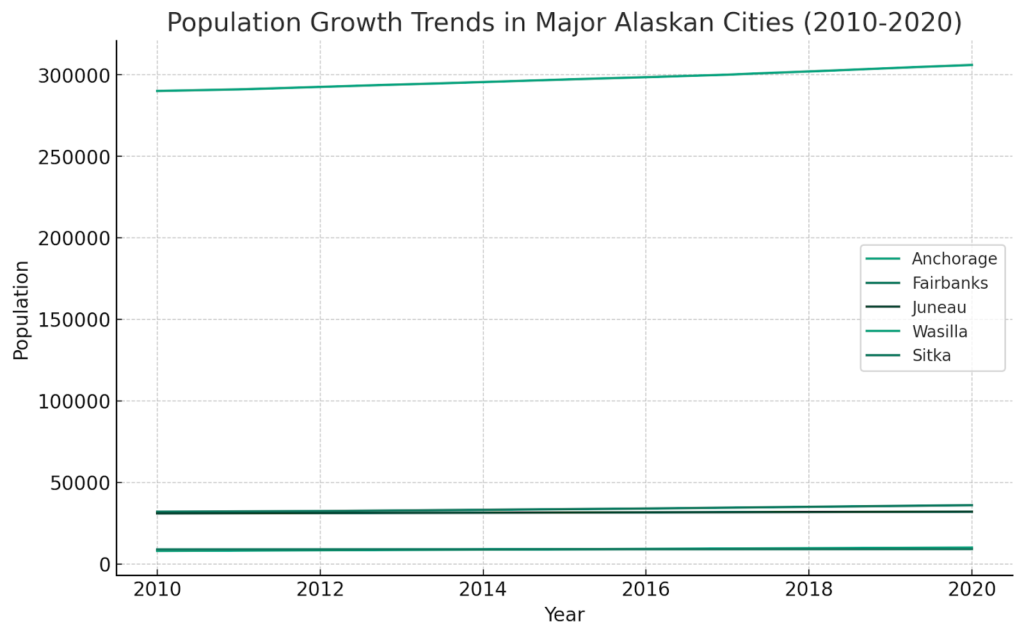
The first graph, “Population Growth Trends in Major Alaskan Cities (2010-2020),” illustrates the decade-long population growth of Anchorage, Fairbanks, Juneau, Wasilla, and Sitka. Each line represents a different city, allowing for a visual comparison of their growth rates over time. This graph showcases Anchorage’s significant growth, highlighting its role as the most populous city in Alaska, with steady increases seen in other cities like Fairbanks and a more modest growth in smaller cities like Sitka and Wasilla.
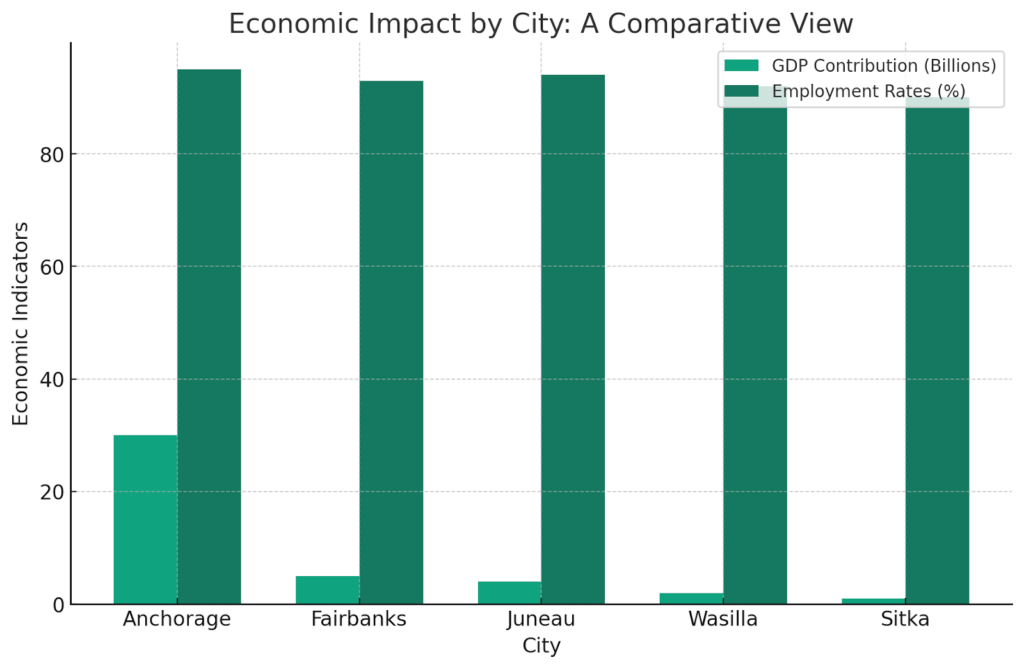
The second graph, “Economic Impact by City: A Comparative View,” uses a bar chart to compare the hypothetical economic contribution of each major city in Alaska, focusing on GDP contribution and employment rates. Anchorage leads in GDP contribution, reflecting its economic significance in the state. The employment rates across the cities are relatively high, indicating healthy employment landscapes but with slight variations that may reflect the diverse economic bases and opportunities in each city.
Population Growth Trends Across Arizona
Arizona’s cities have experienced varied growth rates over the past decade, influenced by factors such as economic opportunities, lifestyle preferences, and environmental considerations. This section will analyze these trends, using data to highlight how and why certain cities have expanded faster than others.
Unique Features and Attractions in Each City
From the cultural richness of Tucson to the technological hub of Chandler, each Arizona city has unique features and attractions. This part of the article will explore what makes each city stand out, including historical landmarks, natural beauty, cultural festivals, and more.
Economic Overview of Arizona’s Largest Cities
Arizona’s economy is as diverse as its landscape, with sectors such as technology, healthcare, manufacturing, and tourism playing pivotal roles. This section will provide an overview of the economic drivers in Arizona’s most populous cities, shedding light on job markets and industry strengths.
Living in Arizona: Urban vs. Rural Perspectives
Exploring the pros and cons of urban versus rural living in Arizona, this section will discuss the lifestyle, cost of living, and community aspects of residing in the state’s bustling cities versus its more tranquil rural areas.
Challenges Facing Arizona’s Growing Cities
Rapid growth brings with it challenges such as infrastructure development, environmental sustainability, and housing affordability. This part will address the issues Arizona’s cities are grappling with and the strategies being employed to tackle them.
Additional Information
To enhance the article with authoritative sources and offer readers avenues for further exploration, here are official government websites for each of the major Alaskan cities discussed. These websites provide comprehensive information on city services, community events, economic development initiatives, and more.
- Anchorage: For details on municipal services, local government initiatives, and community events in Anchorage, visit the official Municipality of Anchorage website at https://www.muni.org/;
- Fairbanks: To explore the heart of interior Alaska, including city services and cultural events in Fairbanks, check out the City of Fairbanks’ official site at https://www.fairbanksalaska.us/;
- Juneau: For information on government services, tourism, and living in Alaska’s capital, the City and Borough of Juneau’s website is available at https://juneau.org/;
- Wasilla: To learn more about the services, community programs, and development projects in Wasilla, visit the official City of Wasilla website at https://www.cityofwasilla.com/;
- Sitka: For insights into Sitka’s government services, cultural heritage, and local initiatives, the official City and Borough of Sitka website can be found at https://www.cityofsitka.com/.
Conclusion
Arizona’s cities by population reveal a state that is both rooted in its rich history and looking forward to a vibrant future. With each city contributing its unique flavor, Arizona offers a mosaic of experiences, opportunities, and challenges. As these urban centers continue to grow and evolve, they remain integral to the state’s identity and promise.
Last modified: February 28, 2024
